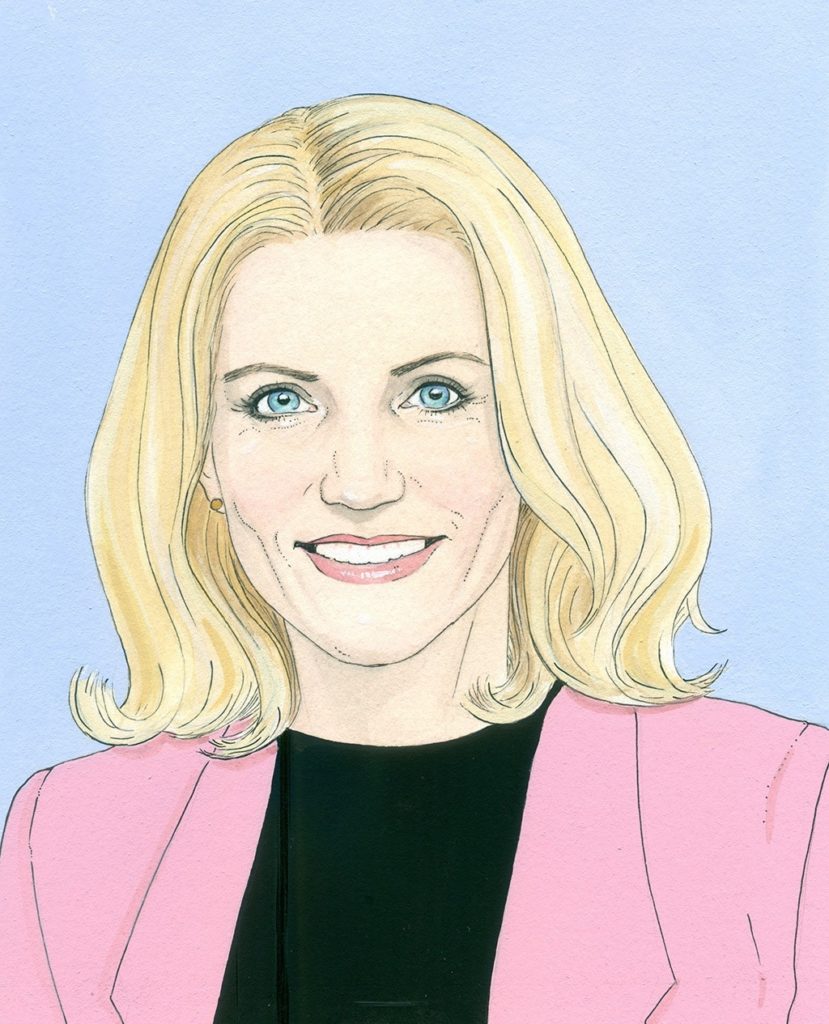Saving children
A conversation with Helle Thorning-Schmidt

Save the Children International was founded by an English woman, Eglantyne Jebb, after World War I to feed starving children. The iconic nongovernmental organization has since grown into a global force at the forefront of international efforts to protect children’s rights.
Whether responding to humanitarian emergencies, advocating for quality education, intervening when children are most vulnerable — in war, natural disasters or extreme poverty — Save the Children receives worldwide recognition as one of the chief protectors and defenders of children in crisis.
Helle Thorning-Schmidt, the organization’s international chief executive officer, is no stranger to diplomacy, advocacy and the global stage. She was Denmark’s first female prime minister and led the nation through the global financial crisis in 2007. She joined Save the Children in 2016.
At an international summit this summer in Dubai, United Arab Emirates, Thorning-Schmidt told the audience that it is a priority to help children in a world of abundant harm where violence impacts 15 million of them. “To my organization, Save the Children, there is nothing more urgent than protecting children in armed conflict,” she said.
Thorning-Schmidt and Executive Editor Paul Costello communicated by email after she returned to London from the opening of the United Nations General Assembly in New York.
Costello: Is this a better world for children or a more threatening world?
Thorning-Schmidt: The world is facing the worst humanitarian crisis since the Second World War. Conflict and drought have fueled a crisis, leaving 20 million people in Somalia, South Sudan, Yemen and northeast Nigeria in urgent need of food and water. Millions more children are growing up in war zones in places like Syria, South Sudan and Yemen. In Yemen, cholera is infecting a child every minute. This is a disease that should have been consigned to the history books. And millions of children have fled their homes as refugees and are now living in limbo without basic supplies or an education. We’re also seeing a new crisis unfold in Bangladesh, where more than a quarter of a million Rohingya children have crossed the border from Myanmar.
This is a crisis on a scale the world has not seen in a long time, and we need powerful action to help those in urgent humanitarian need. But while it is easy to feel pessimistic when hearing about these crises, the good news is that great progress has been made for children over past decades. Children today are healthier, wealthier and better-educated than ever before. We have made great progress, but there is still a long way to go.
Costello: What are the specific dangers that children face when they are displaced and living in refugee camps?
Thorning-Schmidt: Half of all refugees are children. They have had to flee their homes and many then find themselves living in poor conditions without the right food, shelter and health care.
As well as making sure children have access to the basic supplies they need to be healthy, we need to make sure that they don’t miss out on an education.
Half of all refugee children are out of school and this leaves them open to exploitation, radicalization and trafficking. Being in school and learning means these children are safe from dangers like this.
We asked more than 8,000 refugee children and their families what they wanted, and 90 percent of them prioritized education. One day, when peace comes, I hope that the children who have had to flee war-torn countries can return and rebuild their countries. To rebuild their countries, child refugees will need to grow up to become engineers, architects, doctors and business people.
Costello: Save the Children recently published a report that looked at the mental health impact of the war in Syria on children. What are some of the major points?
Thorning-Schmidt: We conducted the largest study ever undertaken of children’s mental health inside Syria during the war. We spoke to 450 children and their parents in places that were besieged, like Aleppo, Damascus, Homs and Idlib. What we found is disturbing — the war is clearly causing deep psychological trauma for the children of Syria. These children have seen and experienced things that no child should ever face. We heard of children wetting the bed, having nightmares, losing the ability to speak and even becoming suicidal.
Experts say that many of these symptoms are in line with “toxic stress,” which is the most dangerous form of stress response a child can experience and can have a lifelong impact on children’s mental and physical health. But a quarter of children interviewed said they had nowhere to turn. Support services in Syria have collapsed, with hospitals bombed and many doctors and professionals having fled the country.
Without the right help, this trauma could affect their future development. But with early interventions, children can recover from traumatic experiences like these. Save the Children is already working to help these children. For instance, we run child-friendly spaces, protected environments for children to learn and play and where they can get psychological support. Education is also an important part of the solution, and we are providing education for Syrian refugee children.
Costello: How critical is national leadership in solving these seemingly intractable problems?
Thorning-Schmidt: Strong leadership from world leaders and institutions like the United Nations is vital.
It is only because of leadership like this that we have progress. Take child mortality. The number of children dying before their fifth birthday is less than half of what it was two decades ago, and millions of children are alive today as a result. Much of that progress was made in China. China’s leaders made a huge effort to reduce the under-5 mortality rate, and it was largely because of that progress that the world met its millennium target on this. Without that kind of leadership there and in other countries, children would be worse off.
And the contribution that many developed countries make in the form of overseas development assistance has also saved the lives of millions of children. I hope that countries around the world continue to be generous like this. A little can go very far, and investing in international development allows governments to help the most vulnerable people in the world while also serving their own people by helping to create a more secure and stable world.
Costello: A significant crisis in many developing nations is lack of access to clean water. What is the impact on children?
Thorning-Schmidt: Every child has the right to clean drinking water and the nutritious diet they need to thrive. Far too many children do not have access to this basic human need, and this is a leading cause of death in children under 5 because of the diseases spread by unsafe drinking water. Every year, 650,000 young children die of diarrhea. Children should not be dying of diseases like this that we can easily prevent. A big part of our work involves working with governments and communities to improve access to proper sanitation and clean drinking water.
I recently visited rural Kenya, where the worst drought in a decade has left many children severely dehydrated and malnourished. Save the Children is running mobile health clinics and delivering emergency supplies to help these children, but in the long term we need to build better infrastructure so that remote communities are not left without clean water when drought hits.
Costello: You travel around the globe and are witness to some of the worst harm inflicted on kids. What gives you the greatest hope?
Thorning-Schmidt: Children give me hope. I meet children who have been through the most unimaginable hardship yet are still full of hope. Children who had to flee war zones and leave their families and belongings behind, street children who live on their own and don’t even have a name and mothers who can’t afford to feed their babies for days. No matter the suffering, they have endured, they still have hope that things will get better. At Save the Children we are working in 120 countries to make sure that hope becomes a reality for children and things do get better. It is the job of all of us to make sure the world does not let these children down again.
